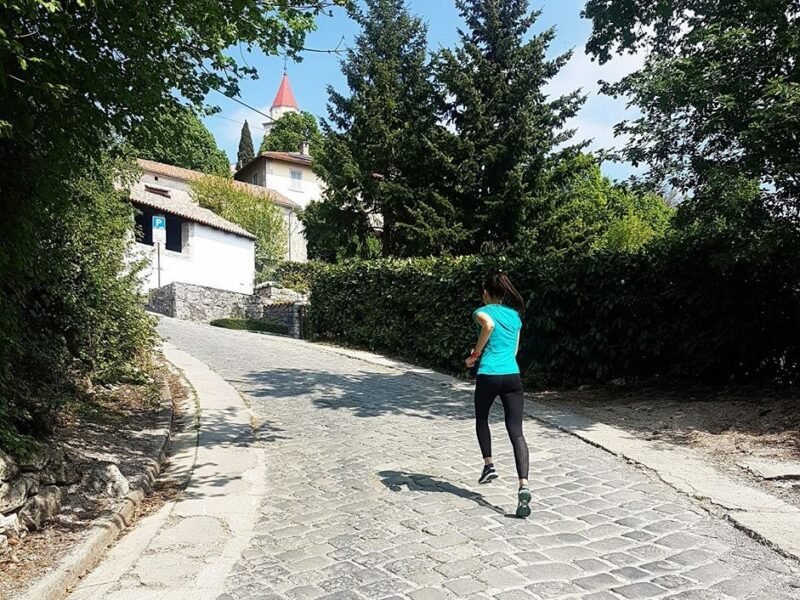Should Beginners Run Hills? (Top 7 Reasons Why They Should)
If you are a beginner runner, you probably have a lot of questions and you are not sure what types of training are advisable.
So, should beginners run hills?
Beginners should run hills because of their versatility. When starting, it is important to do gentler and shorter slopes and adjust the level of effort to your current fitness level to avoid injuries or overtraining.
Tip
If you are a beginner, be mindful. Don’t start running hills until you’ve done approximately 6 to 8 weeks of base training. You should run at least 3 days a week and average about 9 miles a week.
Hill running is quite a demanding workout, not only for beginners but also for intermediate runners.
However, after you discover all the benefits of it, you will no longer avoid it. In fact, you will love it.
Read below why hill running is recommended for beginners.

1. It reduces stress on the joints
Hill running is a great way for beginners to improve their performance with reduced stress on the joints and less risk of injury compared to running on flat ground.
During hill running, the returning force is lower on landing, allowing your muscles to act as shock absorbers more easily.
Due to that, they are more capable of absorbing impact and stress to protect your bones and joints.
Info
Stress on the shins, ankle joints and knee joints is reduced since the returning force becomes lower with each step uphill.
Be careful when running downhill due to the high returning force on landing. Due to that, run downhill at a lower intensity or walk so as not to increase the risk of injury.
Despite that, slower downhill runs are a great way to strengthen and adapt your leg muscles to stress so that they better absorb impact.
2. It could be a great short workout
Hill running is quite demanding. No matter how slow you run or walk uphill, you will lose your breath.
Because of that, it is a great way to increase your heart rate and do a great workout in much less time and with much less stress on the body.
Info
Regular hill running will improve your fitness level, and you will be surprised how easier running on flat ground will get.
3. It allows you to adopt the proper running technique
Hill running is a great workout for beginners since running uphill forces you to run with a proper running technique when compared to running on flat ground:
- you keep your body upright, slightly leaning forward at the hips
- you naturally raise your knees higher
- you do not run on your heels, but on the balls of your feet (depending on the incline)
- you work more intensely with your arms
That way, hill running improves your running technique, making you run more properly on flat ground as well.
This will result in an improved running economy, which means you will be able to maintain the same pace while consuming less energy.
4. It improves your strength
Hill running is a specific type of strength training for all runners, including beginners.
Hill running forces you to better activate your lower body muscles to overcome the resistance of your own weight and gravity.
That way, it strengthens you and develops your overall strength.
Furthermore, during hill running, you work more intensely with your arms when compared to running on flat ground, which helps you develop upper body strength and activate your core.
Tip
Hill running is not an adequate replacement for strength training. Therefore, keep it in your training plan.
Read more: Strength Training for Runners (Top 19 Workout Exercises)
Read more: Top 12 Isometric Exercises for Runners with Workout Example
5. It makes you faster
Hill running strengthens your hamstrings and glutes, allowing you to grab the surface beneath you more efficiently, making you run faster in the process.
Likewise, hill running takes place on the balls of your feet. This way, you develop strength that allows you to push off more explosively from the ground.
By running on the balls of your feet, you spend less time on the surface, which, in turn, makes you faster.
6. It burns more calories
Many beginners start running due to their desire to lose excess weight. When you run uphill, you work against gravity, using your body weight as resistance.
Due to the increased effort, more energy is required, which leads to more calories being burned.
Tip
The steeper the hill, the more energy needs to be invested to overcome it. As a result, you will burn more calories. By adding hill running to your training plan, you will increase your fat-burning potential.

7. It builds self-confidence
Hill running requires much more effort than running on flat ground. For this reason, many runners do not like hill running and tend to avoid it.
Read more: Why is Hill Running so Hard? (10 Ways to Make it Easier)
However, keep in mind that every effort pays off.
Regular hill running will gradually increase your pain threshold and allow you to endure much more discomfort, which will help you build your self-confidence.
Info
By adding hill running to your training plan, you will improve your strength, running technique, and pain tolerance, which will significantly improve your self-confidence.
Read more: 14 Amazing Hill Running Benefits for Runners
How to start running hills?
The safest introduction to hill running is running on undulating terrain.
Initially, choose gentler slopes. Combine walking and running uphill and gradually increase your running segments.
Also, be careful when you’re running downhill. The forces that need to be amortized at each step are much higher and thus the risk of injury is multiplied.
Later on, include specific hill running workouts such as hill repeats or continuous long runs.
Tip
As a beginner, start with shorter and gentler slopes. Do hill repeats of lower intensity, focusing on proper running technique and a smaller number of repetitions. Gradually increase the intensity, distance, and number of repetitions.

Examples of hill running workouts for beginners
Below are 3 examples of hill running workouts that are appropriate for beginners.
Tip
Adjust the intensity to your current fitness level. Don’t bother with running pace, and listen to your body instead.
1. Walking/running combination
Example of walking/running combination
Warm up
– 5 minutes of walking + 5 minutes of easy running on flat ground
The main part of the workout
– 20 seconds of brisk walking uphill + 40 seconds of uphill easy running
– return to the beginning of the uphill by walking slowly
– repeat 6 times
Cooldown
– 10 minutes of walking on flat ground
2. Continuous uphill walking/running
Example of continuous uphill walking/running
Warm up
– 10 minutes of walking on flat ground
The main part of the workout
– 30 seconds of running uphill
– 1 minute of walking downhill
– repeat 10 times
Cooldown
– go downhill slowly and walk for 5 minutes on flat ground
3. Short hill repeats defined by time
Example of short hill repeats defined by time
Warm up
– 10 minutes of easy running on flat ground
The main part of the workout
– 30 seconds of running uphill
– return to the beginning of the uphill by walking slowly
– repeat 8 times
Cooldown
– 5 minutes of easy running on flat ground
If you want to know more about hill training, read the article Hill Training (8 Best Hill Running Workouts).

Matea Matošević
Hi, I’m Matea! I’m an Olympic Marathon Runner, founder, and writer behind OLYRUN.com. On this site, I provide help in the form of my knowledge and experience to all who love running and active living. Read more…

